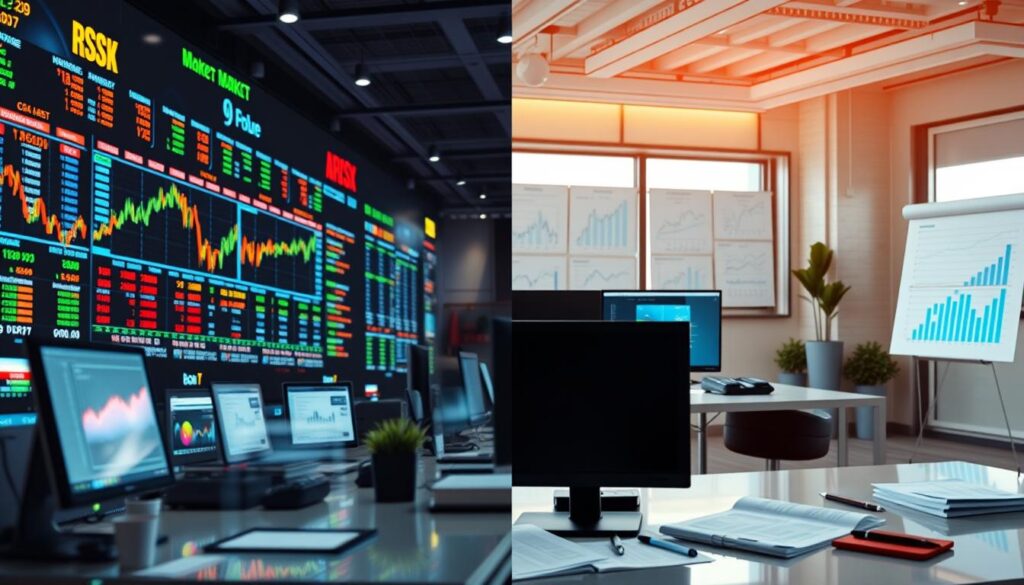Market capitalization, or market cap for short, shows the total value of all a company’s shares. It is calculated by multiplying the share price by the number of shares. This value helps investors understand the size of a company.
In 2024, market cap will be very important for investments and acquisitions. Companies are classified into categories such as large-cap, mid-cap, and small-cap. This helps investors better structure their portfolios and manage risks.

Key findings
- Market capitalization is the total value of a company’s outstanding shares.
- Market cap serves as an indicator of company size and is used for valuations and comparisons.
- Companies are divided into different categories based on their market cap.
- Market cap plays a central role in investment decisions and acquisitions.
- Market capitalization is calculated by multiplying the share price by the number of outstanding shares.
What is Market Capitalization: Basic Definition
Market capitalization, also known as stock market value or company valuation , is very important in the stock market . It shows the value of all a company’s shares. It is calculated by multiplying the share price by the number of shares.
Apple, for example, has six billion shares. Each share is worth $200. This makes Apple’s market capitalization $1.2 trillion. Investors use this to estimate the size of a company relative to others.
Market capitalization also helps evaluate acquisitions. It shows whether a company is fairly priced.
| category | Market capitalization | Characteristics |
|---|---|---|
| Large-cap | Over 10 billion | Lower risk, more stable performance, lower growth potential |
| Mid-Cap | 2 – 10 billion | Balanced risk and growth |
| Small cap | Under 2 billion | Higher growth potential, but also higher risk |
The categorization varies by country, but this classification is widely used. Investors use market capitalization to develop their strategies.
The importance of market cap in modern finance
Market capitalization (market cap) is very important today. It helps investors and analysts quickly determine how large and how capable a company is of growth. It also influences which investments are made, how acquisitions are planned, and how companies are analyzed.
Influence on investment decisions
Market capitalization is an important consideration when selecting investments. Large companies with high market capitalization are often considered safer . Small companies (small caps), on the other hand, can have high growth potential. Market capitalization indicates how large a company is and helps in deciding where to invest.
Role in corporate takeovers
Market capitalization is very important in acquisitions. It helps estimate the acquisition price and the value of the company being acquired. Companies with large market capitalizations are often more attractive for acquisitions because they have greater market power and stable finances.
Significance for stock market analysis
Analysts and stock market experts highly value market capitalization. It indicates how large and capable of growth a company is compared to others. It also influences how companies are classified in indices and funds, which can affect the share price.
Market capitalization is therefore very important for financial market analysis , investment strategies , and acquisition criteria . It is a key indicator that investors and analysts should not ignore.
Calculating market capitalization: formulas and methods
Market capitalization , also known as stock market value or stock valuation , is very important. It shows how much a company is worth. Investors use it to decide whether to invest in a company.
The formula for calculating market capitalization is simple:
Market capitalization = Current share price × Total number of shares outstanding
For example, a company has 15 million shares. The price of each share is €18. This makes the market capitalization €270 million. A similar approach is used for cryptocurrencies . You multiply the price by the number of coins.
Globally, companies like Apple and Saudi Aramco are very valuable. They have market capitalizations exceeding one trillion US dollars. In Germany, SAP is the most valuable company. Its market capitalization is approximately 160 billion euros.
“Market capitalization is a crucial measure of company value and provides investors with important guidance for their investment decisions.”
Different categories of market capitalization
Market capitalization indicates how large a company is. There are several categories that are important for investors.
Large-cap companies (over 10 billion)
Large-cap companies have a market capitalization of over €10 billion. They are established and often dominate their markets. They are stable and liquid.
Investors view large caps as safe investments. They offer good returns.
Mid-cap companies (2-10 billion)
Mid-cap companies have a market capitalization between €2 billion and €10 billion. They offer growth opportunities . They are a good complement to large caps.
But they are riskier because they are smaller.
Small-cap companies (under 2 billion)
Small-cap companies have a market capitalization of less than €2 billion. They are riskier but offer growth potential . They are good for bold investors.
Micro-cap companies with a value below €250 million are considered a separate category.

The categorization is based on market capitalization . This influences investment strategies and risk. Investors should carefully review this stock classification .
Market cap in the cryptocurrency market
Crypto market capitalization reflects the value and size of the cryptocurrency market. It is calculated in the same way as stocks: multiplying the current price of a cryptocurrency by the number of coins or tokens in circulation.
CoinMarketCap.com offers real-time data on crypto market capitalization . There are more than 2 million crypto pairs worldwide. Over 97% of all tokens are listed on the platform.
The diluted market capitalization takes into account all possible coins or tokens, providing a holistic picture of the market value. CoinMarketCap provides investors and traders with free real-time crypto charts and historical data. This data is useful for technical analysis.
| Cryptocurrency | Market capitalization (in billion US dollars) |
|---|---|
| Bitcoin | 578.1 |
| Ether | 218.3 |
| Tether | 62.0 |
| Binance Coin | 47.1 |
| Cardano | 36.1 |
Market capitalization is important for evaluating cryptocurrencies. It shows the total market value of a digital currency. In the cryptocurrency sector, crypto market capitalization is just as important as it is in traditional financial markets.
Factors influencing market capitalization
Two main factors influence a company’s market capitalization: stock prices and share buybacks by the company.
Stock price fluctuations
Many things can influence a stock price, including company results, market conditions, and economic events. These fluctuations change the company’s value on the stock market.
Share buybacks and new issues
When a company buys back its own shares, the number of shares decreases. This lowers the market capitalization. In contrast, when the company issues new shares, the market capitalization increases.
Market capitalization is constantly changing. It depends on stock prices and corporate actions. Investors should be aware of these factors to make wise investment decisions .
“Market capitalization is an important indicator of a company’s value and performance, but should not be used as the sole valuation criterion.”
Advantages and disadvantages of market capitalization as a valuation method
Market capitalization is a popular method for valuing companies. It’s easy and quickly accessible, helping investors compare companies quickly.
A major disadvantage is that it doesn’t reflect a company’s true value. It can also be influenced by market capitalization criticism .
Another disadvantage is that debt or assets are not taken into account. This can provide an incomplete picture of a company’s financial health. Furthermore, market capitalization can fluctuate significantly without any change in the company’s situation.
| Advantages of market capitalization | Disadvantages of market capitalization |
|---|---|
| Easy and quick availability | Does not reflect intrinsic value |
| Enables comparison between companies | Not taking into account debts or assets |
| First clue for investors | Susceptible to market volatility |
In summary, market capitalization provides a quick overview. But it is not sufficient for evaluating companies. Investors should combine financial metrics with other methods to obtain a comprehensive picture of company valuation methods .
“Market capitalization is a useful but incomplete indicator of company value. Investors should always consider other financial metrics for valuation.”
Difference between market capitalization and enterprise value
Market capitalization (market cap) indicates a company’s market value . It is calculated by multiplying the number of shares by the current price. However, it does not reflect the company’s total value.
In contrast, enterprise value also considers debt and cash holdings, providing a better picture of a company’s true value.
Enterprise Value vs. Market Cap
Enterprise value is calculated by adding and subtracting market capitalization, debt, and cash holdings. This method provides a more accurate value for a company and is therefore often used in acquisitions.
Key figures in comparison
There are other financial metrics , such as the price-to-earnings ratio (P/E) and the enterprise value-to-EBITDA ratio (EV/EBITDA) . The P/E ratio uses market capitalization, while the EV/EBITDA ratio considers enterprise value.
These metrics help investors analyze companies effectively, enabling them to make better decisions about investments or acquisitions.

“Enterprise value provides a more accurate picture of a company’s true value than market capitalization alone.”
Market Cap and IPOs: What Investors Need to Know
An initial public offering (IPO) is a pivotal moment for a company. It significantly impacts market capitalization . Investment banks determine the IPO price through careful valuation.
After an IPO, market capitalization can fluctuate rapidly. This depends on demand and market conditions. Investors should be aware of post-IPO volatility.
In traditional IPOs, banks receive a commission of 5% to 7%, making the process smoother. Direct listings like Spotify and Slack are more cost-effective because they do not involve banks.
Reverse IPOs result in a merger with a publicly listed company. No fresh capital is raised directly. Later capital increases are necessary.
Special Purpose Acquisition Companies (SPACs) are a popular alternative to traditional IPOs. They are time efficient.
In traditional IPOs, institutional and private investors can participate by subscribing to shares. In direct listings, everyone can buy directly on the first day of trading.
In reverse IPOs, investors can purchase shares of the listed company. They should be aware of the dilution caused by corporate actions.
To participate in a stock market debut via a SPAC, private investors can purchase shares of the SPAC.
| method | Participation for private investors | Advantages and disadvantages |
|---|---|---|
| Traditional IPO | About share subscription with affiliated brokers | + High liquidity – High costs due to bank commissions |
| Direct Listing | Direct purchase on the stock exchange | + Cost-effective – Lower liquidity |
| Reverse IPO | Purchase of shares of the already listed company | + No fresh capital needed – risk of dilution |
| SPAC | Buying SPAC shares on the stock exchange | + Time efficient – Less transparency |
A realistic IPO valuation is crucial for success. Founders should stay with their company long-term. This demonstrates confidence in the business model.
The minimum capitalization for attractive IPOs is approximately €100 million. This amount attracts international investors and enables a liquid secondary market.
IPOs are strategically, financially, and image-building important for companies. Investors should consider the specifics of equity offerings when making their decisions.
Market capitalization in international comparison
The world of stock markets is very diverse. Big names like Apple, Microsoft, and Amazon dominate the US. LVMH and Nestlé are leading the way in Europe. China, especially with Tencent and Alibaba, also plays a major role.
A comparison of market capitalizations shows the strength of different countries. GOLD has the highest value at $18,439 trillion. Tencent, SAP, and Coca-Cola are also among the top companies.
| Pursue | Market capitalization (in billion $) |
|---|---|
| GOLD | 18,439 |
| Tencent (TCEHY) | 492.38 |
| SAP | 276.48 |
| Coca-Cola (KO) | 280.05 |
| Netflix | 323.2 |
| Alibaba (BABA) | 233.59 |
| IBM | 192.55 |
| McDonald’s (MCD) | 211.76 |
| General Electric (GE) | 185.82 |
| Verizon (VZ) | 174.11 |
The top four brands—Amazon, Microsoft, Apple, and Google—have seen significant increases in value, rising by between 78% and 324%. This demonstrates the importance of global stock markets.
“Market capitalization can be calculated by multiplying the number of shares by the price.”
International comparisons demonstrate how dynamic and complex the global markets are. Investors and analysts must closely monitor this analysis to adjust their strategies.
Technical Analysis and Market Cap
Technical stock analysis is very important for evaluating companies. It looks at market capitalization , which indicates how large and important a company is.
Chart analysis and market capitalization
Experts closely monitor market capitalization. They look for trends and patterns. For example, doji candles and Fibonacci retracement levels help you find important clues.
Volume patterns and trends
Trading volume is also important. High volume often indicates strong trends and high interest. Analysts monitor how volume and market capitalization develop.
Technical analysis uses market capitalization to identify trends, allowing you to make sound decisions.
“Market capitalization is a crucial factor in technical analysis because it provides information about the size and importance of a company in the financial market.”
The role of market capitalization in ETFs
Many exchange-traded funds (ETFs) are based on market-capitalization-weighted indices. This means that companies with large market capitalizations have a larger share in the ETF. This method indicates how large and important the companies are in the market.
There are also other weighting methods, such as equal-weighted or fundamental-weighted ETFs. These attempt to reduce the power of large companies, creating a more balanced ETF structure .
Market capitalization as the basis for ETF indices offers advantages for investors. It accurately reflects the market and the actual weighting of companies. Investors benefit from broad diversification at low costs through passive investing .
“Market capitalization is an important factor in constructing ETFs because it reflects the relative size and importance of companies in the market.”
However, market-capitalization-weighted indices also carry risks. The danger is that mega-caps have too much weight, which can affect the ETF’s risk profile. Therefore, alternative weighting methods are becoming increasingly popular to reduce this concentration.
Market capitalization plays a key role in ETF construction . Investors should understand these factors to make wise decisions.
Risk management based on market cap
Market capitalization is important for portfolio risk management. Diversification across different market capitalization classes can reduce risk and improve returns.
Diversification strategies
Large-cap companies are often more stable and less volatile. Small-cap companies offer higher returns but also higher risks. Risk diversification across these categories reduces portfolio risk.
Portfolio weighting
Portfolio weighting can be adjusted depending on investment strategy and risk tolerance. Conservative investors often hold more large-cap stocks. Risk-averse investors focus more on small-cap stocks.
Market capitalization is key in risk management. Balanced diversification and appropriate portfolio weighting promote investment success.
Current trends and developments 2024
There will be exciting innovations in the market in 2024. Technology stocks will remain important, and ESG (environmental, social, and governance) factors will also become more important.
Things are happening quickly in the cryptocurrency market . The launch of Bitcoin ETFs in the US in January 2024 opens new doors for investors.
There is a slight decline in economic growth, especially in developed markets. However, private equity transactions and investments in renewable energy remain attractive. The European Crowdfunding Service Provider Regulation (ECSP Regulation) also offers new opportunities for diversification.
In 2024, there are many market trends that will interest everyone. Developments in technology, ESG, and cryptocurrencies will be important. Economics will also have an impact.
“Market capitalization will continue to be a key factor in investment decisions in 2024. Investors must closely monitor current trends and developments to optimally position their portfolios.”
– Max Mustermann, financial analyst
Conclusion
Market capitalization is very important for investors and financial analysts. It shows how large and valuable a company is. But it shouldn’t be viewed in isolation. Other financial metrics and important factors must also be considered.
In the fast-paced financial world of 2024, it’s important to properly understand market capitalization. You need to know what it means and where its limits lie.
Before making investment decisions , you should analyze everything thoroughly. Professional advice is also important. A good understanding of financial education and market analysis helps you make better decisions.
Market capitalization is a useful tool, but it must be viewed in the context of the company or market. This allows investors to make smart decisions and capitalize on the opportunities in the financial world of 2024.
